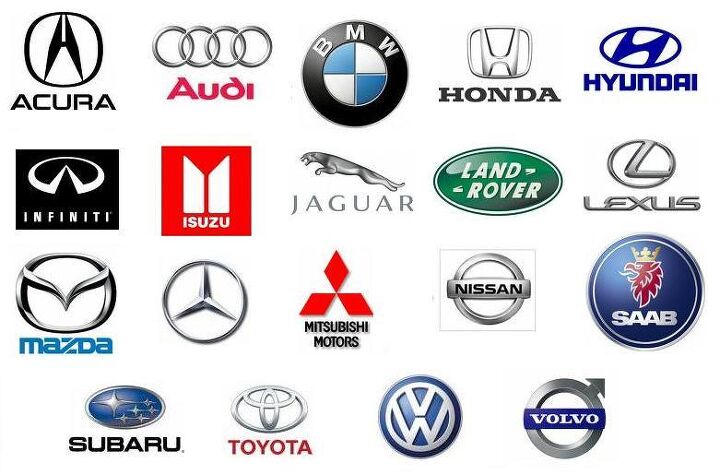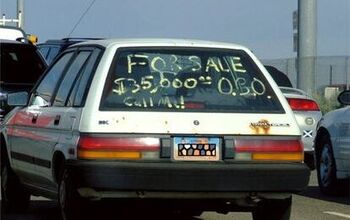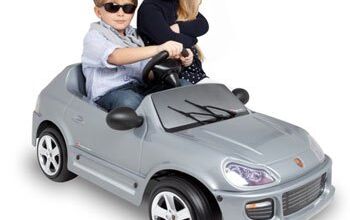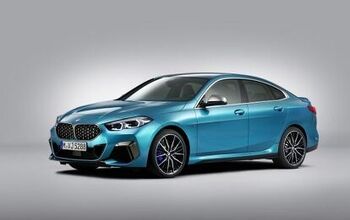Hammer Time: Some Buy Cars, Others Buy Names
October and the first half of November have historically been a great time for dealers to buy cars on the cheap. There are no spending holidays. No Christmas or end of the year bonuses. No tax refunds. Not even a hint of federal legislation that may push old beaters onto the ‘cheap’ side of the ledger.
But there are thousands of used car sales managers that see nothing but big losses on much of their inventory at this time of year. The green Hummer that seemed like such a great deal back in red-hot June may be molderizing at the back of the lot by November. Same goes for the trade-in’s that were valued perhaps a bit too strong… just so the deal on the new car could get done.
This is usually a great time to buy. But not always.
Here are some of my most recent purchases:
- 1993 Lexus LS400 (Auto, Leather, 180k $725)
- 1996 Chevy Camaro (5-speed, V6, Leather, Black, Large Spolier, $1815)
- 1998 Lincoln Navigator (Auto, Leather, 190k $1815)
- 1998 Lincoln Town Car (Auto Leather, 176k, $1525)
- 1998 Mercedes E320 Wagon (MB Tex, Records, 166k, $2725)
- 1998 Ford Explorer XLT (Auto, Leather, 140k, $575)
- 1999 Toyota Camry CE (Auto, Cloth, Inop, $500)
- 1999 Dodge Caravan (Gov’t Vehicle, 109k, 3.0L V6, $590)
- 1999 Cadillac Escalade (Auto Leather, 212k, $2450)
- 2002 Saturn SL2 (Auto, Silver, Power Pkg, 104k, $900)
- 2002 Chevy Tracker (Auto, 4WD, V6, ZR2 model $2315)
- 2003 Saturn Ion Coupe (Auto, Side Graphics, 120k, $2815)
- 2003 Cadillac Seville SLS (Leather, Dealer Records, 125k, $2015)
- 2005 Chevy Malibu Maxx (Auto, V6, 115k, $3670)
- 2005 Ford Freestyle SE (Leather, 149k, $3170)
This is quite a list… and it reflects a few buying realities for the author. From the beginning you’ll notice that I avoid most older European vehicles and buy a bit heavy on the domestics. I also tend to stay under $3500 due to lower down payments ($500 to $1000) and favor vehicles that have leather interiors.
The European Sleds
Saabs, Jaguars, and VWs tend to be problematic at these lower price ranges, while Audi’s, BMW’s, Land Rovers and Mercs are usually far, far worse. When I was a ‘cash’ dealer I simply looked at the ownership histories and bought the ones that had the best combination of dealer maintenance and low wear regardless of the brand.
However when you finance a vehicle, you have to pay special attention towards getting vehicles that can withstand abuse and neglect. Not to mention having reasonable cost of repairs. In my experiences, most European models from the late 90’s and early 2000’s will become buggy high maintenance bastards. So I avoid them like the plague.
When I (rarely) buy one of the brands above, it will usually be a wagon model that has a very strong dealer maintenance history. Larger wagons in particular tend to have less abusive and more affluent owners. In days of yore, Volvos in particular lived up to this standard.
Volvos: Then and Now
Volvos used to be my absolute favorite for this ‘conservative’ combination. In fact Volvos and Subarus tended to make up nearly a quarter of what I sold when I first started. But the ETM issues of 1999-2002 combined with the transmission and electrical issues of more recent Volvos makes them far more chancy than in times past.
Sometimes making the wrong maintenance recommendations (lifetime transmission fluid) or chronic electrical and software issues can kill a brand. That’s Volvo in a nutshell.
The Second-Tiers: Why old Kias will never be like Hyundais
I am far more liberal when it comes to the domestics, Korean (except Kia until the most recent models), and the Japanese (except Mitsubishi, Suzuki, Isuzu, and certain Mazda models). The brands that I put in the proverbial parentheses I do buy… but just not in as large quantities as everything else.
To be blunt, most of these models I buy in smaller quantities because they have trouble selling and making the note. Weak trannies, a propensity for oil leaks, abysmal quality levels and an orientation towards ‘cheap’ low end trim makes these brands proverbial paperweights at the low end side of the range. As the old saying goes at the auctions, “Everyone wants a great deal on an eight year old Kia… until they actually drive one.”
One brief little story related to Kias. The funniest thing I ever saw at an auction came from an auctioneer who had always managed to get himself deep-sixed for shooting his mouth off at just the wrong time. Upon seeing a Kia rolling up to the block he bellowed out, “This was the shittiest car in America until they made the Daewoo!” Needless to say the seller flew into a rage and his time on the block didn’t last very long.
Domestics: Most GM and Fords, A Few Chryslers
The domestics pretty much fare down this way…
1) Rear wheel drive is more durable than front wheel drive
Japanese Models: Why do the good become bad?
Japanese models come in two tiers. Toyota, Honda, Nissan (some models) and Subaru are in the higher tier. Why? Because they almost always sell for more money, wholesale and retail.
It doesn’t matter if the vehicle had engine sludge, or transmission issues, or a blown head gasket in the past. It doesn’t matter if the car is as new as the day the two ‘parts cars’ met and decided to kiss on their first and only date. The fact that this ‘new’ used car has the right name on it’s grille makes it highly attractive to the buying public. Same goes for Hyundai.
As I mentioned earlier I used to buy a lot of Subarus. But that changed around 2007 and now I buy no more than a few a year.
The same is true for the other brands and their more luxurious namesakes. 9 times out of 10 they will go for stiff price premiums at the auctions, and due to the lack of used car inventory at the sales, you’re likely getting a mediocre product at a premium price. At least when it comes to the lower end of the market ($3500 or less wholesale).
The other Japanese brands are seond tiers that are just hard to sell. A few models may go for premiums (Evo, Mazda 3, Mazda 5, etc) but those are simply not the ones you find on the lower end. Aerio, Reno, Verona, 626, Millenia, Rodeo, and Galants are far more common at the sales. If they have a nice upscale interior and a good maintenance history I will put them on my list.
The Bubble Market: Wall Street’s Next Rendezvous
Ironically, these same brands tend to sell well for the higher end buy-here pay-here lots that are looking for the newest vehicles. Why? Because they offer steep levels of depreciation along with healthy NADA values if they happen to be late models (2007 and newer).
Most folks are clueless about cars. A thick slice of them just want a late model vehicle at a monthly payment they can afford. Even if it’s for the next five to seven years. Then more times than not, they repeat the cycle.
Dealers who specialize in financing a bad credit customer with a late model vehicle will usually sell the paper to finance companies after a given time period. It will then be resold to a financial firm that doesn’t know any better, or will be kept if the assets and customers are perceived as less risky.
The Game… and how not to play it…
Thanks to the declining fortunes of the middle-class, there is a lot of money in this game. Sales at buy-here pay-here dealerships are up by more than 50% from only five years ago and the dirty secret of the modern day is that even the best names in the business now make their money by attracting the hard to finance customer to their ‘superstores’.
So for those of you in the market for a car… please do yourselves a big favor. Don’t buy a name. Don’t buy a low price. Don’t buy anything based on words… especially from a dealer who exchanges ‘convenience’ for a high sales price.
Buy the prior owner. Drive what you enjoy. Look at the history. Have it independently inspected, and then keep it up so that you don’t have to suffer the slings and arrows of outrageous sub-prime misfortunes. My series on buying a used car should help. Good luck!
More by Steven Lang
Latest Car Reviews
Read moreLatest Product Reviews
Read moreRecent Comments
- EBFlex It’s ironic that the typical low IQ big government simps are all over this yet we’re completely silent when oil companies took massive losses during Covid. Funny how that’s fine but profits aren’t. These people have no idea how business works.
- Ajla Goldman Sachs 🥂
- Rna65689660 DVR and watch all that are aired. Has been this way for 40 years.
- Kwik_Shift_Pro4X The only car racing I'll watch is rally car.
- Offbeat Oddity The price is definitely too high, but this generation of Accord has still been very reliable- not far off from the Camry. I believe the CVTs in these have held up very well, so while not ideal, it wouldn't deter me- the mileage is just way too high.


































Comments
Join the conversation
I can understand buying cheap cars and flip them as a business. What I don't understand is why would an individual buy one cheap car, when he has the resource to buy a better one? For instance, I would never touch a 20 year old Lexus LS. If I want a nice Toyota sedan and don't want to pay the new LS price, I will just buy a new 2012 Camry. The overall comfort and ownership cost would be better.
4) Never finance a domestic with a CVT. Always, always make those cash deals Does this suggest that all CVTs are generally less reliable than standard autoboxes? I have never been able to get a straight answer on this. Or is this just a comment on the saleability of used domestic CVTs?